Lithofacies Characteristics and Pore Controlling Factors of New Type of Permian Unconventional Reservoir in Sichuan Basin
Abstract
1. Introduction
2. Geological Setting
3. Samples and Methods
4. Results
4.1. Observation of Outcrop and Core Samples
4.2. Quantitative Analysis of Mineral Components
4.3. Organic Matter Abundance
4.4. Lithofacies
4.4.1. Tuff
4.4.2. Sedimentary Tuff
4.4.3. Tuffaceous Mudstone
5. Discussion
5.1. Pore Types
5.2. Mineral Enrichment
5.2.1. Sulphur-Bearing Mineral Enrichment
5.2.2. Organic Matter Enrichment
5.3. Controlling Factors
5.3.1. Relationship between Mineral Composition and Pore
5.3.2. Relationship between TOC Content and Pore
5.3.3. Relationship between Tuffaceous Component and Pore
5.3.4. Relationship between Devitrification and Dissolution and Porosity
6. Conclusions
- (1)
- The Permian tuffaceous rocks in the Sichuan Basin are divided into three main lithofacies types, including tuff, sedimentary tuff, and tuffaceous mudstone. The tuffs mainly include detritus tuff and crystal tuff. The sedimentary tuff and tuffaceous mudstone often occur interbedded and are stratified. The mineral composition of the three lithofacies includes quartz, feldspar, carbonate minerals, pyrite, and clay, and the feldspar is mainly potassium feldspar. The tuffs have the highest feldspar, quartz and pyrite content, and the lowest clay and TOC content. The tuffaceous mudstones have the highest clay and TOC content and the lowest feldspar and quartz and pyrite content. The sedimentary tuffs are intermediate between the tuff and tuffaceous mudstone.
- (2)
- The pore types in the tuffaceous rocks mainly include shrinkage pores, dissolved pores, intergranular pores, organic pores. Shrinkage pores mainly include shrinkage pores formed during the alteration of pyroclastic material and inter-clay shrinkage pores. Shrinkage pores are the common type, usually at the nano-scale, accounting for 81.9% of the total pores. Organic pores account for 11.2% of the total pore space.
- (3)
- The feldspar and quartz content, and pyrite content in the tuffaceous rocks are inversely correlated with porosity, while the clay content and TOC content are positively correlated with porosity. The higher the tuff content in the three lithofacies, the lower the porosity; therefore, tuff has the lowest porosity, followed by sedimentary tuff, and tuffaceous mudstone has the highest porosity.
- (4)
- Tuffaceous rocks form many micropores in the process of devitrification. Organic matter pyrolysis and organic acid dissolution also increase the reservoir space and porosity for the reservoir.
- (5)
- The marine tuffaceous rocks have an overall high TOC content and porosity, and thus have a hydrocarbon generation capacity and reservoir space. They could be hydrocarbon source rocks and reservoirs. As a new type of reservoir, they could form self-accumulation and self-reservoir types of tight reservoirs, with the characteristics of co-generation of the source and reservoir, lithology reservoir, and broad plane distribution, and thus they have great exploration prospects.
Author Contributions
Funding
Institutional Review Board Statement
Informed Consent Statement
Data Availability Statement
Conflicts of Interest
References
- Vernik, L. A new type of reservoir rock in volcaniclastic sequences. AAPG Bull. 1990, 74, 830–836. [Google Scholar] [CrossRef]
- Cao, Y.C.; Jiang, Z.X.; Qiu, L.W. Study on the type and origin of the reservoir space of igneous oil reservoir in Shang 741 Block, Huimin Depression, Shandong. Acta Petrol. Sin. 1999, 15, 129–136, (In Chinese with English Abstract). [Google Scholar]
- Levin, L.E. Volcanogenic and volcaniclastic reservoir rocks in Mesozoic-Cenozoic island arcs: Examples from the Caucasus and the NW Pacific. J. Pet. Geol. 1995, 18, 267–288. [Google Scholar] [CrossRef]
- Schutter, S.R. Occurrences of hydrocarbons in and around igneous rocks. Geol. Soc. Lond. Spec. Publ. 2003, 214, 35–68. [Google Scholar] [CrossRef]
- Gecer, B.A. Diagenesis of tipper Eocene volcaniclastic rocks and its relevance to hydrocarbon exploration in the Thrace Basin, Turkey. Energy Sources 2006, 28 Pt A, 1039–1049. [Google Scholar]
- Ma, X.H.; Xu, C.C.; Li, G.H.; Ying, D.L.; Zhang, B.J.; Li, Y.; Dai, X.; Fan, Y.; Zeng, Y.X. Distribution and gas bearing properties of Permian igneous rocks in Sichuan Basin SW China. Pet. Explor. Dev. 2019, 46, 216–225. [Google Scholar] [CrossRef]
- Zhang, J.; Liu, G.; Cao, Z.; Tao, S.; Felix, M.; Kong, Y.; Zhang, Y. Characteristics and formation mechanism of multi-source mixed sedimentary rocks a saline lake. an ease study of the Permian Lucaogou Formation in the Jimu-Saer Sag, northwest China. Mar. Pet. Geol. 2019, 102, 704–724. [Google Scholar] [CrossRef]
- Lenhardt, N.; Götz, A.E. Volcanic settings and their reservoir potential: An outcrop analog study on the Miocene Tepoztlán Formation, Central Mexico. J. Volcanol. Geotherm. Res. 2011, 204, 66–75. [Google Scholar] [CrossRef]
- Huang, K.; Opdyke, N.D. Magnetostratigraphic investigations on an Emeishan basalt section in western Guizhou Province, China. Earth Planet. Sci. Lett. 1998, 163, 1–14. [Google Scholar] [CrossRef]
- Zhou, M.F.; Malpas, J.; Song, X.Y.; Robinson, P.T.; Sun, M.; Kennedy, A. A temporal link between the Emeishan large igneous province (SW China) and the end-Guadalupian mass extinction. Earth Planet. Sci. Lett. 2001, 196, 113–122. [Google Scholar] [CrossRef]
- Ali, J.R.; Thompson, G.M.; Song, X.Y.; Wang, Y.L. Emeishan Basalts (SW China) and the ‘end-Guadalupian’ crisis: Magnetobiostratigraphic constraints. J. Geol. Soc. 2002, 159, 21–29. [Google Scholar] [CrossRef]
- Zhang, H.F.; Wu, X.S.; Wang, B.; Duan, Y.J.; Qu, Y.; Chen, D.F. Research Progress of the Enrichment Mechanism of Sedimentary Organics in Lacustrine Basin. Acta Sedimentol. Sin. 2006, 34, 463–477, (In Chinese with English Abstract). [Google Scholar] [CrossRef]
- Zhong, H.; Zhu, W.G.; Chu, Z.Y.; He, D.F. SHRIMP U-Pb zircon geochronology, geochemistry, and Nd-Sr isotopic study of contrasting granites in the Emeishan large igneous province, SW China. Chem. Geol. 2007, 236, 112–137. [Google Scholar] [CrossRef]
- Peate, I.U.; Bryan, S.E. Re-evaluating plume-induced uplift in the Emeishan large igneous province. Nat. Geosci. 2008, 1, 625–629. [Google Scholar] [CrossRef]
- Hong, Z.; Zhu, W.G.; Hu, R.Z.; Xie, L.W.; He, D.F.; Feng, L.; Chu, Z.Y. Zircon U-Pb age and Sr-Nd-Hf isotope geochemistry of the Panzhihua A-type syenitic intrusion in the Emeishan large igneous province, southwest China and implications for growth of juvenile crust. Lithos 2009, 110, 109–128. [Google Scholar] [CrossRef]
- Wignall, P.B.; Sun, Y.; Bond, D.P.G.; Izon, G.; Newton, R.J. Volcanism, Mass Extinction, and Carbon Isotope Fluctuations in the Middle Permian of China. Science 2009, 342, 1179–1182. [Google Scholar] [CrossRef]
- Shellnutt, J.G.; Denyszyn, S.W.; Mundil, R. Precise age determination of mafic and felsic intrusive rocks from the Permian Emeishan large igneous province (SW China). Gondwana Res. 2012, 22, 118–126. [Google Scholar] [CrossRef]
- Zhu, J.; Zhang, Z.C. The Link between Large igneous provinces and the two mass extinction events in Permian: Review of recent progress the Permian. Geol. Rev. 2013, 1, 137–148, (In Chinese with English Abstract). [Google Scholar]
- Tian, J.; Lin, X.; Guo, W.; Zhang, X.; Huang, P. Geological significance of oil and has in the eruption event in Sichuan Basin Permian basalt China. J. Cheng Du Univ. Technol. Sci. Technol. Ed. 2017, 44, 14–20, (In Chinese with English Abstract). [Google Scholar] [CrossRef]
- Ma, X.H.; Yang, Y.; Zhang, J.; Xie, J.R. A Major discovery in Permian volcanic rock gas reservoir exploration in the Sichuan Basin and its implications. Oil Gas Geol. 2019, 39, 1–8. [Google Scholar] [CrossRef]
- Wen, L.; Li, Y.; Yi, H.Y.; Liu, X.; Zhang, B.J.; Qiu, Y.C.; Zhou, G.; Zhang, X.H. Lithofacies and reservoir characteristics of Permian volcanic rocks in the Sichuan Basin. Oil Gas Geol. 2019, 39, 17–27. [Google Scholar] [CrossRef]
- Liu, K.L.; Yang, S.; Chen, H.D.; Li, Q.; Ma, L.; Zhang, C.G. Characteristics and evolution of Permian volcanic rocks in Huayingshan area, eastern Sichuan basin. Miner. Petrol. 2020, 40, 37–49, (In Chinese with English Abstract). [Google Scholar]
- Hu, D.F. Breakthrough in natural gas exploration in the platform margin shoal at the Maokou Fm in the Yuanba area, Sichuan Basin, and its implications. Oil Gas Geol. 2019, 39, 1–10, (In Chinese with English Abstract). [Google Scholar] [CrossRef]
- Tian, X.W.; Luo, B.; Sun, Y.T.; Liu, R.; Li, Y.; Chen, Y.Q.; Zhou, C.L.; Wang, H.; Li, Y.D.; Wang, W.; et al. Natural Gas Characteristics and Source Analysis of Permian Volcanic Gas Reservoir: A Case Study of Well YT1in Chengdu-Jianyang Area, Sichuan Basin. J. Jilin Univ. Earth Sci. Ed. 2021, 51, 325–335, (In Chinese with English Abstract). [Google Scholar]
- Streck, M.J.; Grunder, A.L. Crystallization and welding variations in a widespread ignimbrite sheet: The Rattlesnake Tuff, eastern Oregon, USA. Bull. Volcanol. 1995, 60, 545–567. [Google Scholar] [CrossRef]
- Wilson, C.J.N.; Hildreth, W. Assembling an ignimbrite: Mechanical and thermal building blocks in the Bishop Tuff, California. J. Geol. 2003, 111, 653–670. [Google Scholar] [CrossRef]
- Inoue, A.; Meunier, A.; Beaufort, D. Illite-smectite mixed-layer minerals in felsic volcaniclastic rocks from well drilling cores, Kakkonda, Japan. Clay Min. 2004, 52, 66–84. [Google Scholar] [CrossRef]
- Ddani, M.; Meunier, A.; Zahraoui, M.; Beaufort, D.; El Wartiti, M.; Fontaine, C.; Boukili, B.; El Mahi, B. Clay mineralogy and chemical composition of bentonites from the Gourougou volcanic massif (northeast Morocco). Clay Min. 2005, 53, 250–267. [Google Scholar] [CrossRef]
- García-Romero, E.; Vegas, J.; Baldonedo, J.L.; Marfil, R. Clay minerals as alteration products in basaltic volcanicalstic deposits of La Palma (Canary Islands, Spain). Sediment. Geol. 2005, 174, 237–253. [Google Scholar] [CrossRef]
- Cheng, R.H.; Shen, Y.J.; Yan, J.B.; Li, Q.F.; Li, X.H.; Wang, Y.W.; Li, F.; Xu, Z.J. Diagenesis of volcaniclastic rocks in Hailaer basin. Acta Petrol. Sinca 2010, 26, 47–54, (In Chinese with English Abstract). [Google Scholar]
- Yanik, G.; Esenli, F.; Uz, V.; Esenli, V.; Uz, B.; Kuelah, T. Ceramic properties of kaolinized tuffaceous rocks in Kesan region, Thrace, NW Turkey. Appl. Clay Sci. 2010, 48, 499–505. [Google Scholar] [CrossRef]
- Wang, W.W.; Jang, Z.X.; Xie, X.Y.; Guo, J.X.; Yang, Y.P. Sedimentary characteristics and interactions among volcanic, terrigenous and marine processes in the Late Permian Kuishan Member, Eastern Block of the North China Craton. Sediment. Geol. 2020, 407, 105741. [Google Scholar] [CrossRef]
- Xiang, F.; Yu, X.; Huang, H.; Zhang, D.; Zhu, X. Mineralogical characterization and diagenetic history of Permian marine tuffaceous deposits in Guangyuan area, northern Sichuan basin, China. Mar. Pet. Geol. 2021, 123, 104744. [Google Scholar] [CrossRef]
- Fan, X.Y.; He, L.; Zhang, Q.G.; Zhao, P.F.; Zhang, M.M.; Yao, B.W.; Ran, J.W.; Song, J.C.; Li, K.R. Effect of hydration on Pore Structure and Physical Properties of Permian Basalt and tuff in Sichuan Basin during pressurized imbibition. J. Pet. Sci. Eng. 2022, 213, 10332. [Google Scholar] [CrossRef]
- Li, Q.; Lu, H.; Li, J.; Wu, S.; Wu, Y.; Wen, L.; He, Y.; Qi, F. Characteristics and Formation Mechanism of the Tight Tuff Reservoirs of the Upper Triassic Chang 7 Member in the Southern Ordos Basin, China. Mar. Pet. Geol. 2022, 139, 105625. [Google Scholar] [CrossRef]
- Tian, Y.; Zhang, X.Y.; He, Y.B.; Luo, J.X.; Zhou, H.; Zhou, X.P.; Du, H.Q. Lithofacies paleogeography of Late Permian Wujiapingage in Sichuan Basin. J. Paleogeography 2010, 12, 164–176, (In Chinese with English Abstract). [Google Scholar]
- He, J.; Zheng, R.C.; Hu, X.; Zhang, B.J.; Yin, H.; Ma, H.L.; Wang, Y.; Feng, C.Q. Sedimentary system of the Late Permian Wujiaping Formation in the western Sichuan Basin. Oil Gas Geol. 2015, 36, 87–95, (In Chinese with English Abstract). [Google Scholar] [CrossRef]
- Tian, Y. Lithofacies Palaeogeography of the Upper Permian Wujiaping Period in the Sichuan Basin. Master’s Thesis, China University of Geosciences, Beijing, China, 2018. [Google Scholar]
- Xia, M.L.; Wen, L.; Li, Y.; Luo, B.; He, K.L.; Liu, R.; Qiu, Y.C.; He, Q.L.; Chen, K. Permian volcanic eruption cycle, environment and model in the Jianyang area of the Sichuan Basin. Oil Gas Geol. 2020, 40, 11–22, (In Chinese with English Abstract). [Google Scholar]
- Zeng, Q.; Tian, Y.Y.; Zheng, C.; Wang, X.L.; Li, R.R. Distribution of sedimentary tuff in Wujiaping Formation, northwestern Sichuan Basin and Its geological significance. Nat. Gas Technol. Econ. 2020, 14, 20–26, (In Chinese with English Abstract). [Google Scholar] [CrossRef]
- Peng, H.; Yin, C.; He, Q.L.; Xia, G.Y.; Liu, Y.; Ma, T.H.; Chen, K.; Liu, R.; Su, W. Development characteristics and petroleum geological significance of Permian pyroclastic flow volcanic rocks in Western Sichuan Basin, SW China. Pet. Explor. Dev. 2022, 49, 56–67, (In Chinese with English Abstract). [Google Scholar] [CrossRef]
- Schmid, R. Descriptive nomenclature and classification of pyroclastic deposits and fragments. Geol. Rundschchau 1981, 70, 794–799. [Google Scholar] [CrossRef]
- Rossignol, C.; Hallot, E.; Bourquin, S.; Poujol, M.; Jolivet, M.; Pellenard, P.; Ducassou, C.; Nalpas, T.; Heilbronn, G.; Yu, J.; et al. Using volcaniclastic rocks to constrain sedimentation ages: To what extent are volcanism and sedimentation synchronous? Sediment. Geol. 2019, 381, 46–64. [Google Scholar] [CrossRef]
- Schmincke, H.U. Volcanism; Springer: Berlin/Heidelberg, Germany, 2004. [Google Scholar] [CrossRef]
- Jones, M.T.; Gislason, S.R. Rapid releases of metal salts and nutrients following the deposition of volcanic ash into aqueous environments. Geochim. Et Cosmochim. Acta 2008, 72, 3661–3680. [Google Scholar] [CrossRef]
- Song, G.X.; Qin, K.Z.; Li, G.M.; Wang, L. Basic characteristics and research progresses of intermediate sulfidation type epithermal gold poly-metallic deposits, and prospects. Acta Petrol. Sin. 2018, 34, 748–762, (In Chinese with English Abstract). [Google Scholar]
- Jiang, Z.F. Influence of Volcanic Ash on Source Rock Organic Matter Enrichment in the Lucaogou Formation, the Jimusar Depression. Master’s Thesis, China University of Petroleum (East China), Dongying, China, 2019. (In Chinese with English Abstract). [Google Scholar]
- Li, J.Q.; Lu, S.F.; Cai, J.C.; Zhang, P.F.; Xue, H.T.; Zhao, X.B. Adsorbed and free oil in lacustrine nanoporous shale: A theoretical model and a case study. Energy Fuels 2018, 32, 12247–12258. [Google Scholar] [CrossRef]
- Li, J.Q.; Lu, S.F.; Xie, L.J.; Zhang, J.; Xue, H.T.; Zhang, P.F.; Tian, S.S. Modeling of hydrocarbon adsorption on continental oil shale: A case study on n-alkane. Fuel 2017, 206, 603–613. [Google Scholar] [CrossRef]
- Zou, C.N.; Zhu, R.K.; Bai, B.; Yang, Z.; Wu, S.T.; Su, L.; Dong, D.Z.; Li, X.J. First discovery of nano pore throat in oil and gas reservoir in China and its scientific value. Acta Petrol. Sin. 2011, 27, 1857–1864, (In Chinese with English Abstract). [Google Scholar]
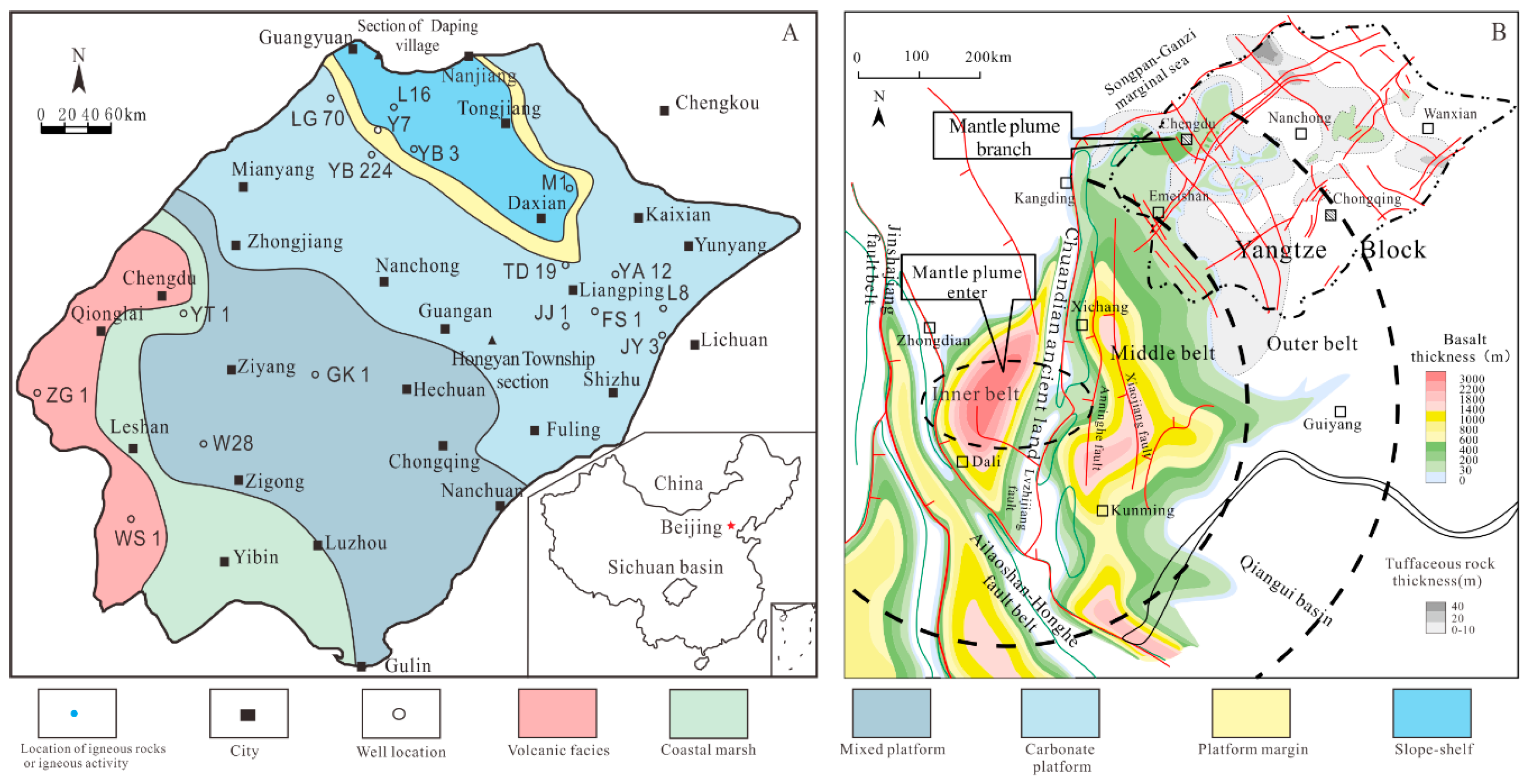
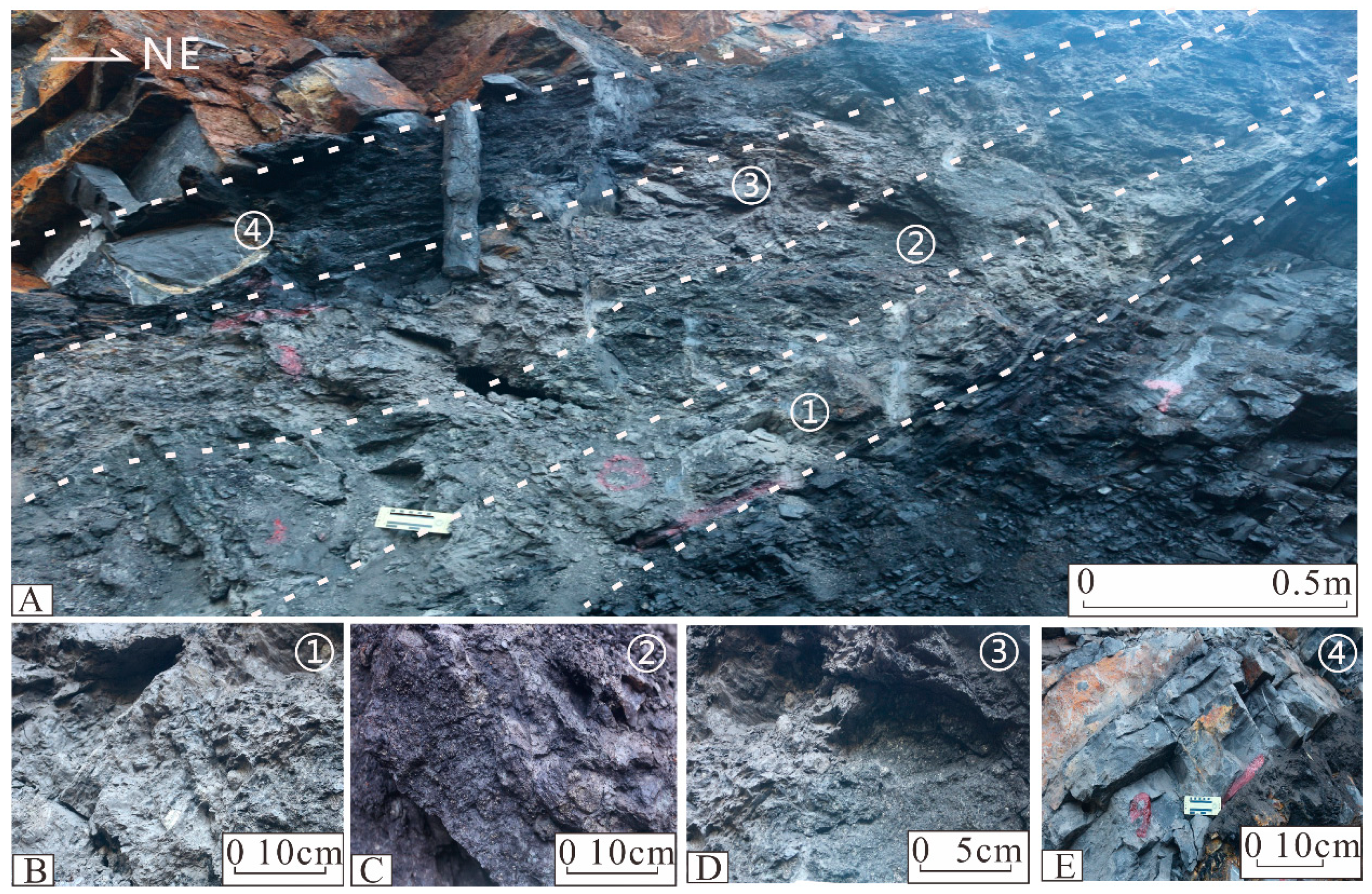
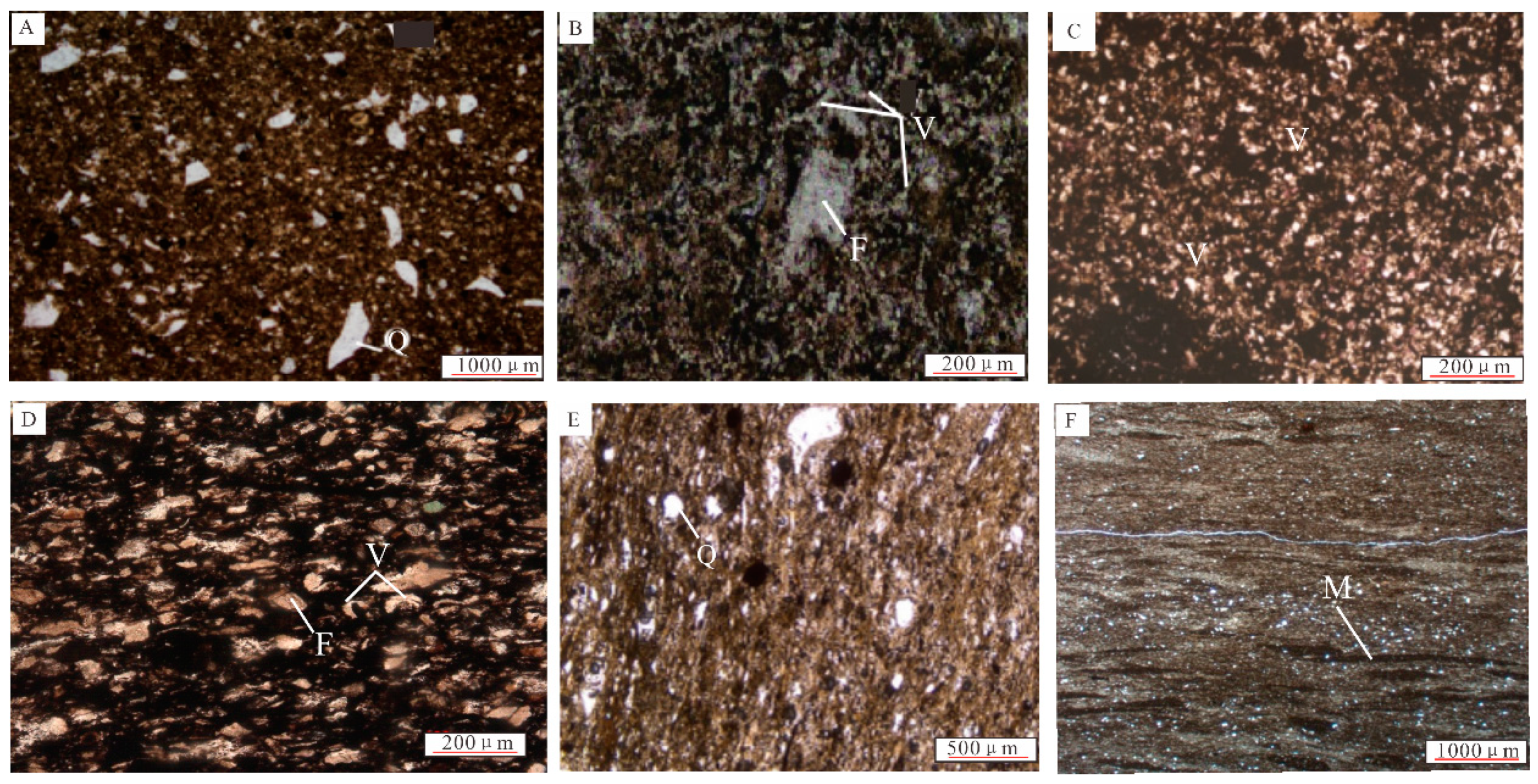
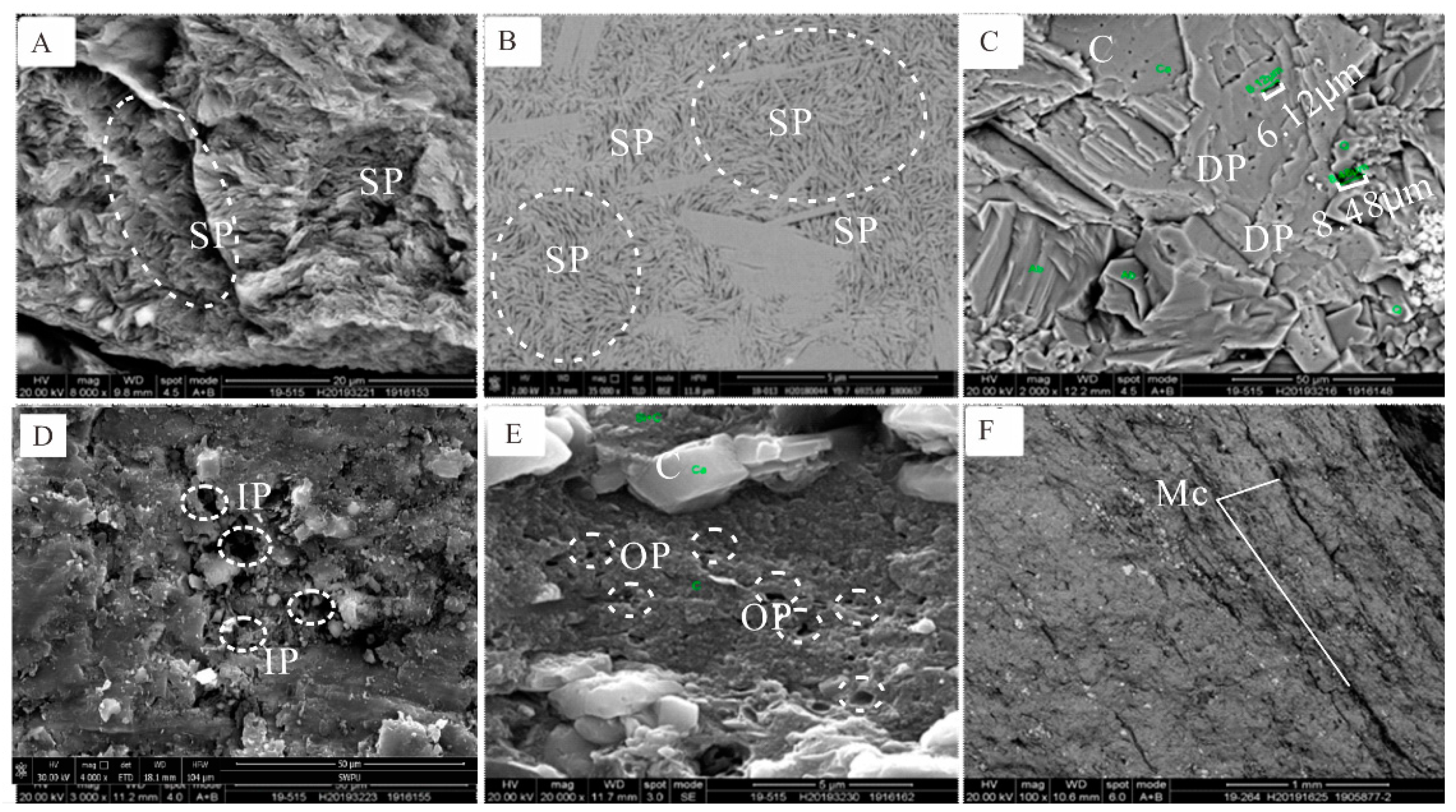
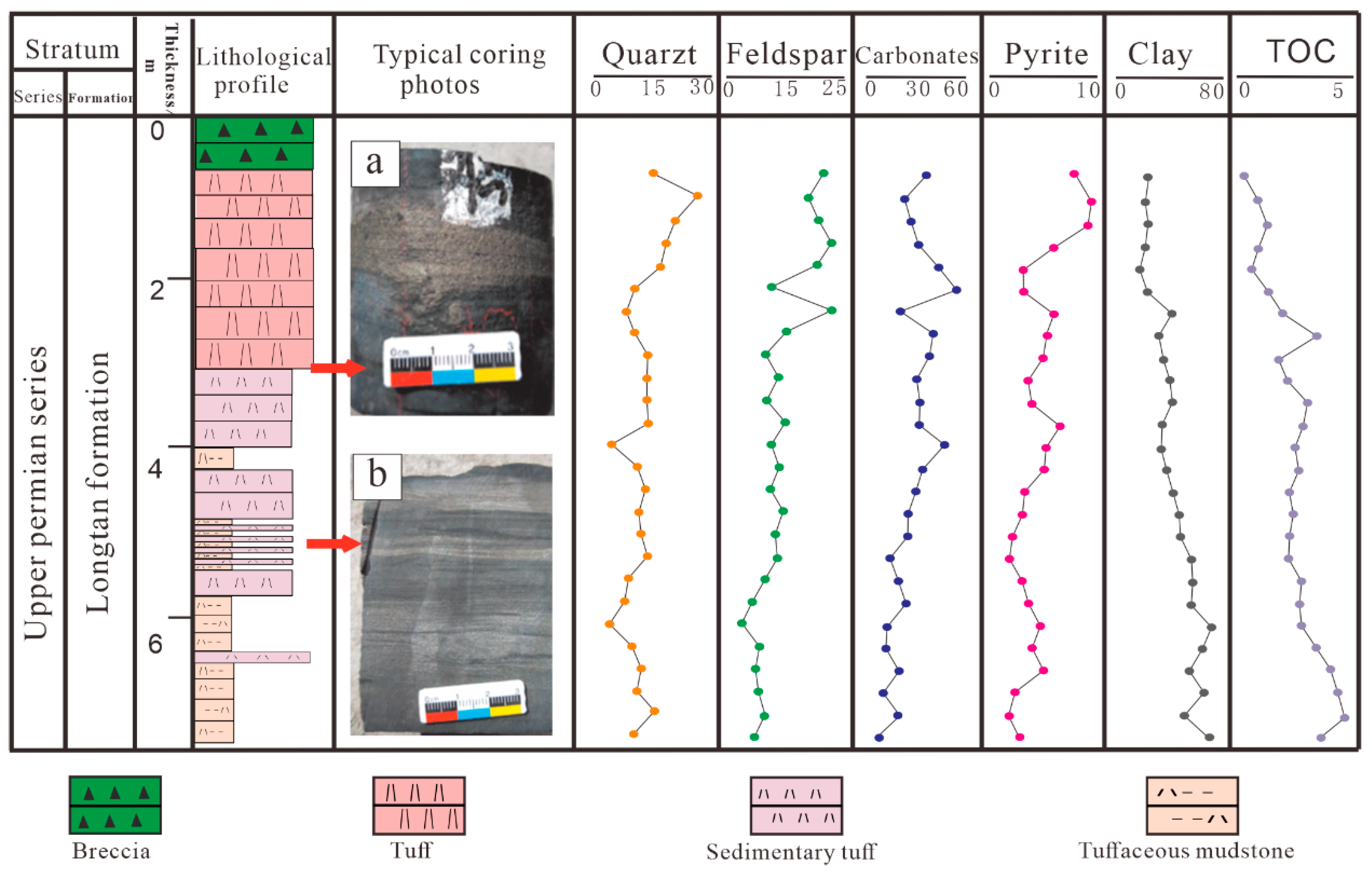


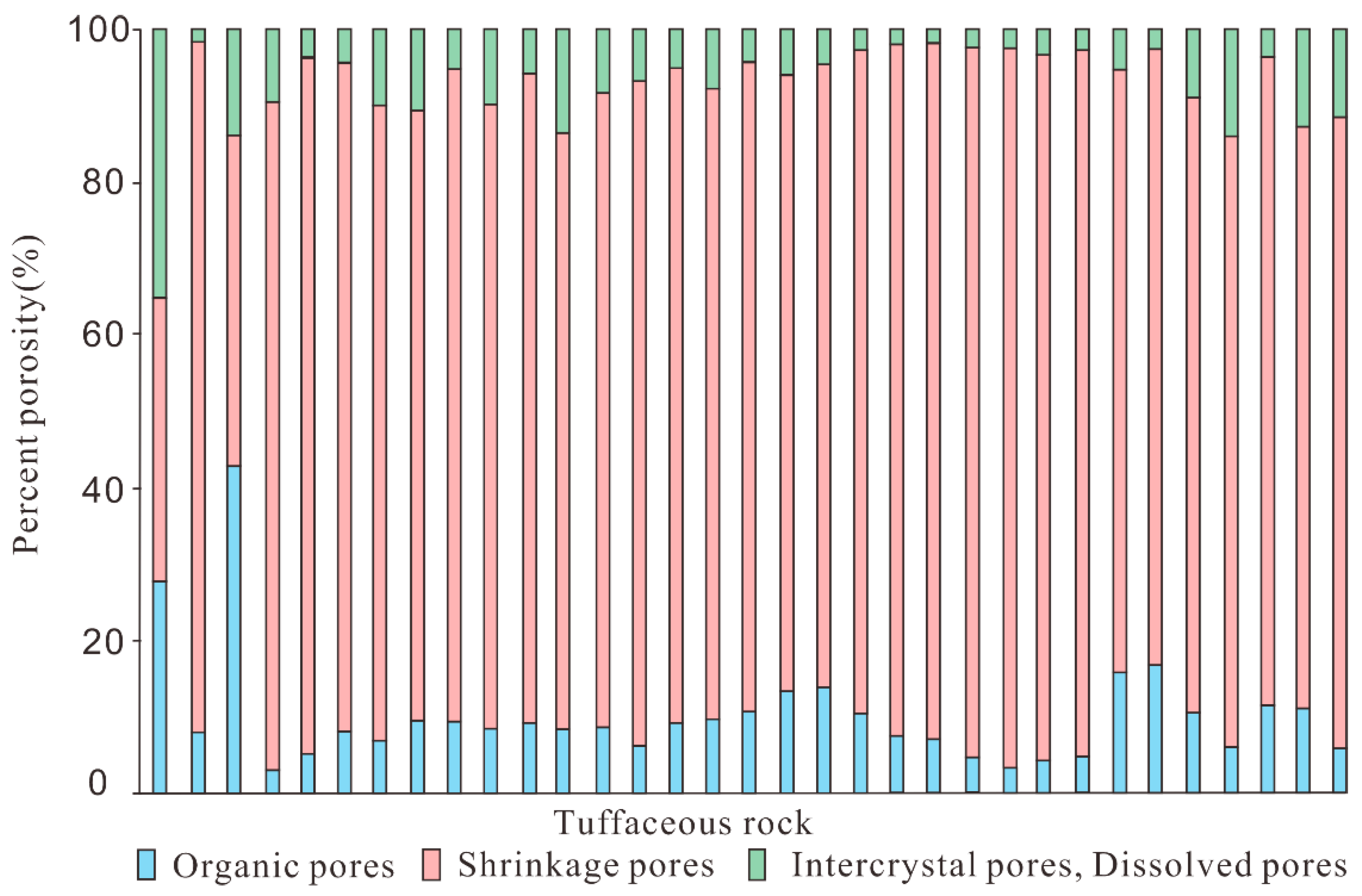
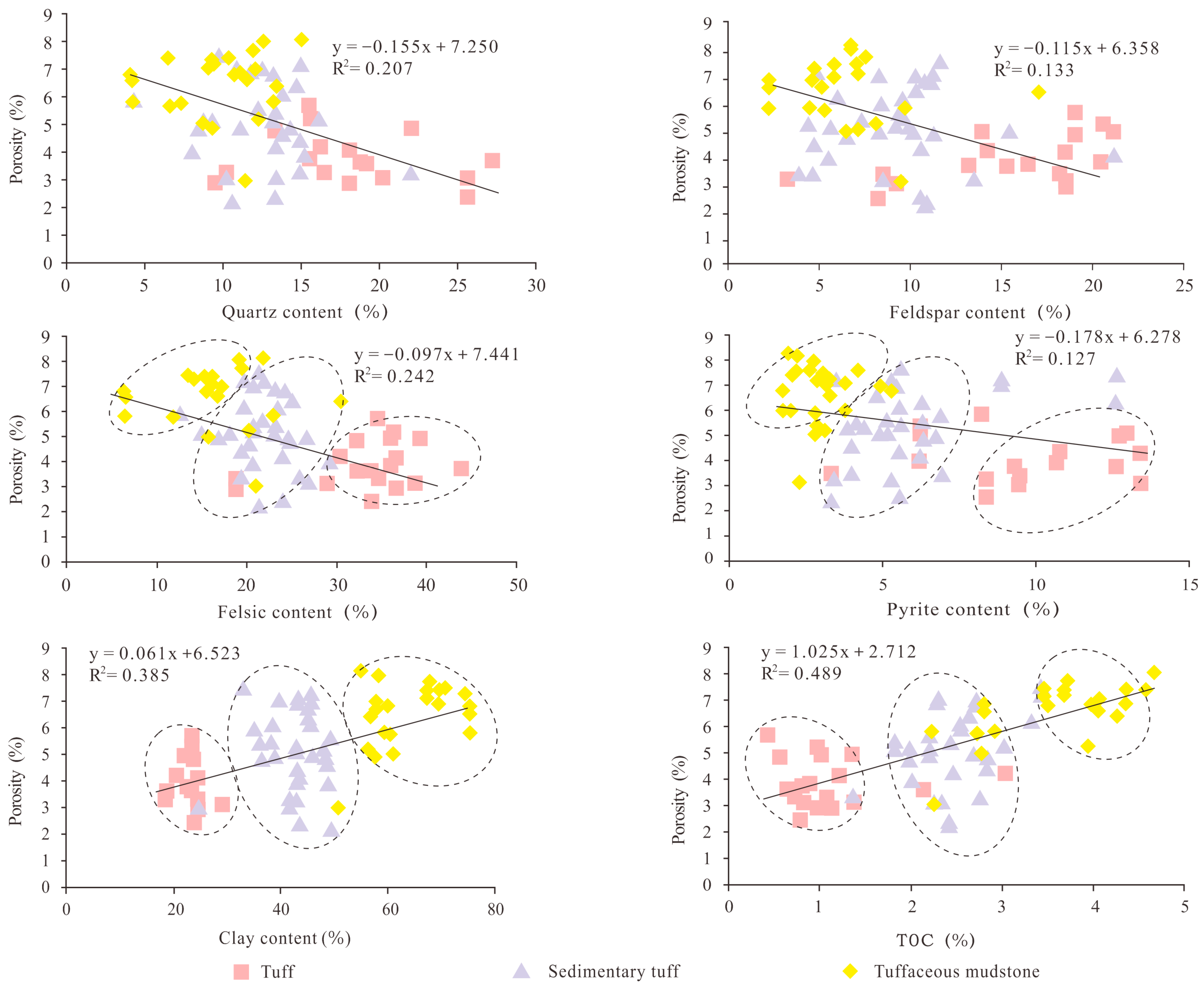
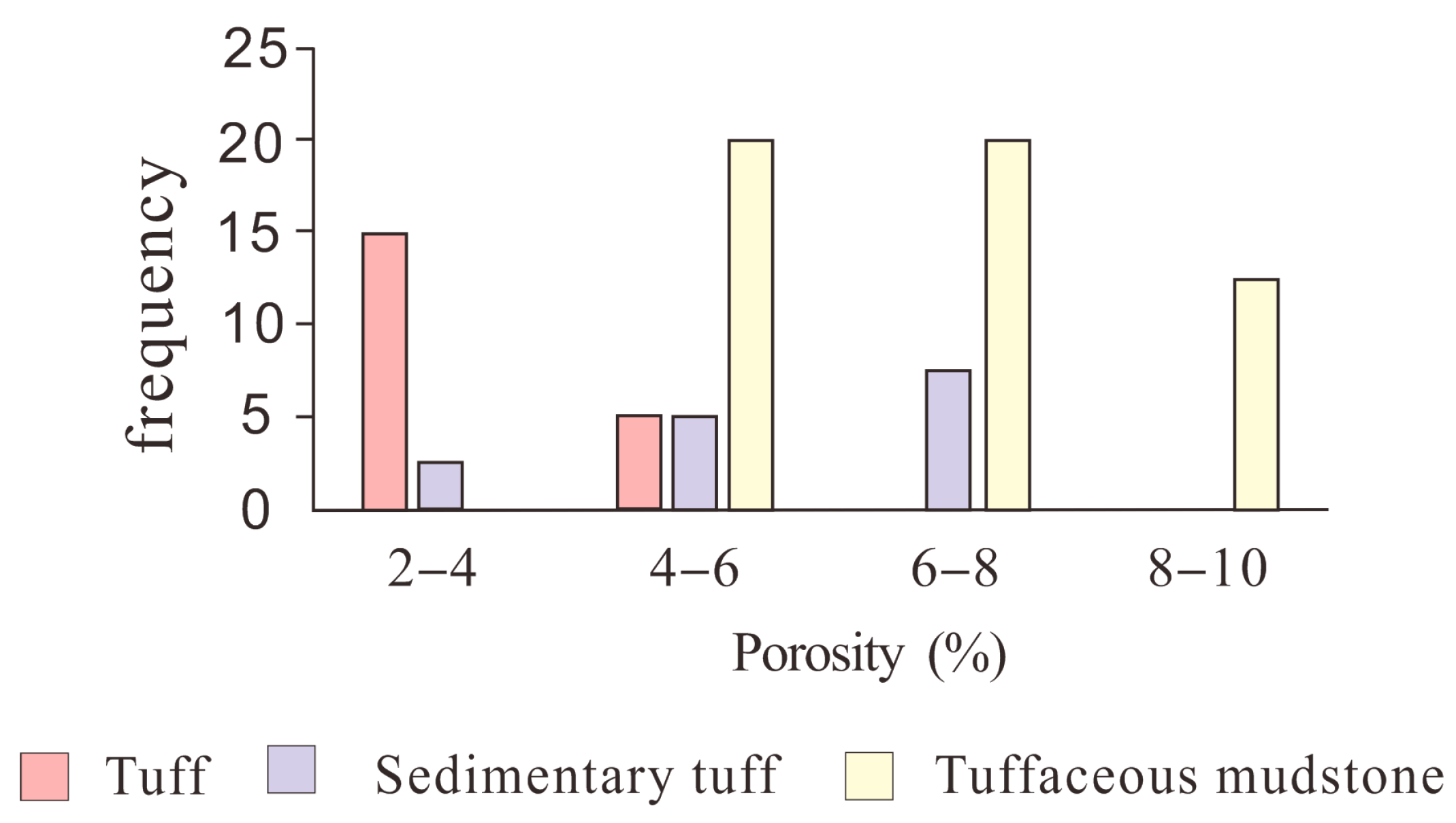
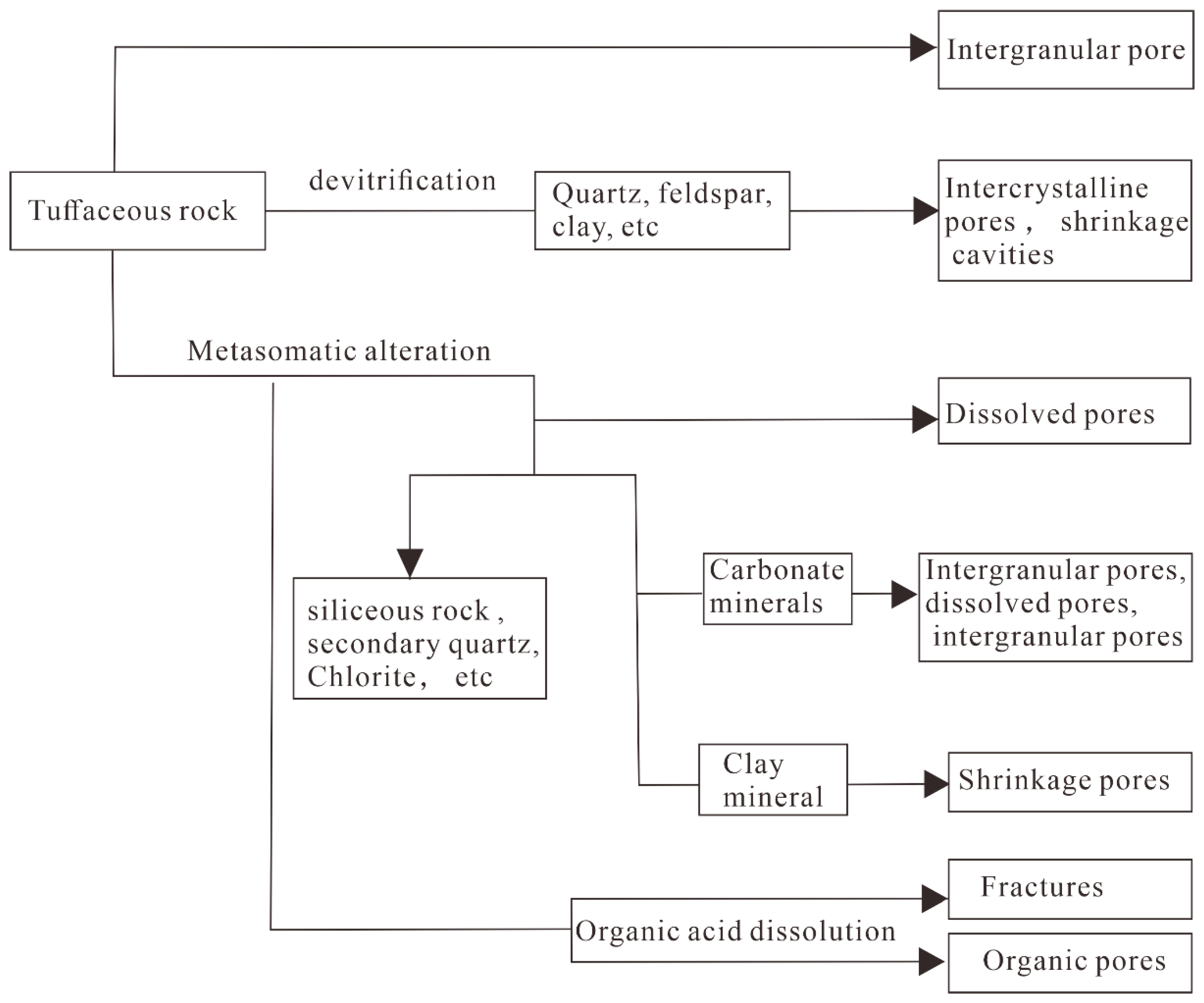
| Types | Rocks | Component | Sedimentary Structures |
|---|---|---|---|
| Normal pyroclastic rocks | Tuff | Composition of pyroclastic debris ranges between 75% and 90% | Insignificant stratification |
| Sedimentary pyroclastic rocks | Sedimentary tuff | Composition of pyroclastic debris ranges between 50% and 75%; Composition of terrestrial debris <50% | Significant stratification |
| Pyroclastic sedimentary rocks | Tuffaceous mudstone | Composition of clay mineral >50%; Composition of pyroclastic debris >10% | Significant stratification |
Disclaimer/Publisher’s Note: The statements, opinions and data contained in all publications are solely those of the individual author(s) and contributor(s) and not of MDPI and/or the editor(s). MDPI and/or the editor(s) disclaim responsibility for any injury to people or property resulting from any ideas, methods, instructions or products referred to in the content. |
© 2023 by the authors. Licensee MDPI, Basel, Switzerland. This article is an open access article distributed under the terms and conditions of the Creative Commons Attribution (CC BY) license (https://creativecommons.org/licenses/by/4.0/).
Share and Cite
Li, R.; Xiong, Z.; Wang, Z.; Xie, W.; Li, W.; Hu, J. Lithofacies Characteristics and Pore Controlling Factors of New Type of Permian Unconventional Reservoir in Sichuan Basin. Processes 2023, 11, 625. https://doi.org/10.3390/pr11020625
Li R, Xiong Z, Wang Z, Xie W, Li W, Hu J. Lithofacies Characteristics and Pore Controlling Factors of New Type of Permian Unconventional Reservoir in Sichuan Basin. Processes. 2023; 11(2):625. https://doi.org/10.3390/pr11020625
Chicago/Turabian StyleLi, Rong, Zhifu Xiong, Zecheng Wang, Wuren Xie, Wenzheng Li, and Jiuzhen Hu. 2023. "Lithofacies Characteristics and Pore Controlling Factors of New Type of Permian Unconventional Reservoir in Sichuan Basin" Processes 11, no. 2: 625. https://doi.org/10.3390/pr11020625
APA StyleLi, R., Xiong, Z., Wang, Z., Xie, W., Li, W., & Hu, J. (2023). Lithofacies Characteristics and Pore Controlling Factors of New Type of Permian Unconventional Reservoir in Sichuan Basin. Processes, 11(2), 625. https://doi.org/10.3390/pr11020625





